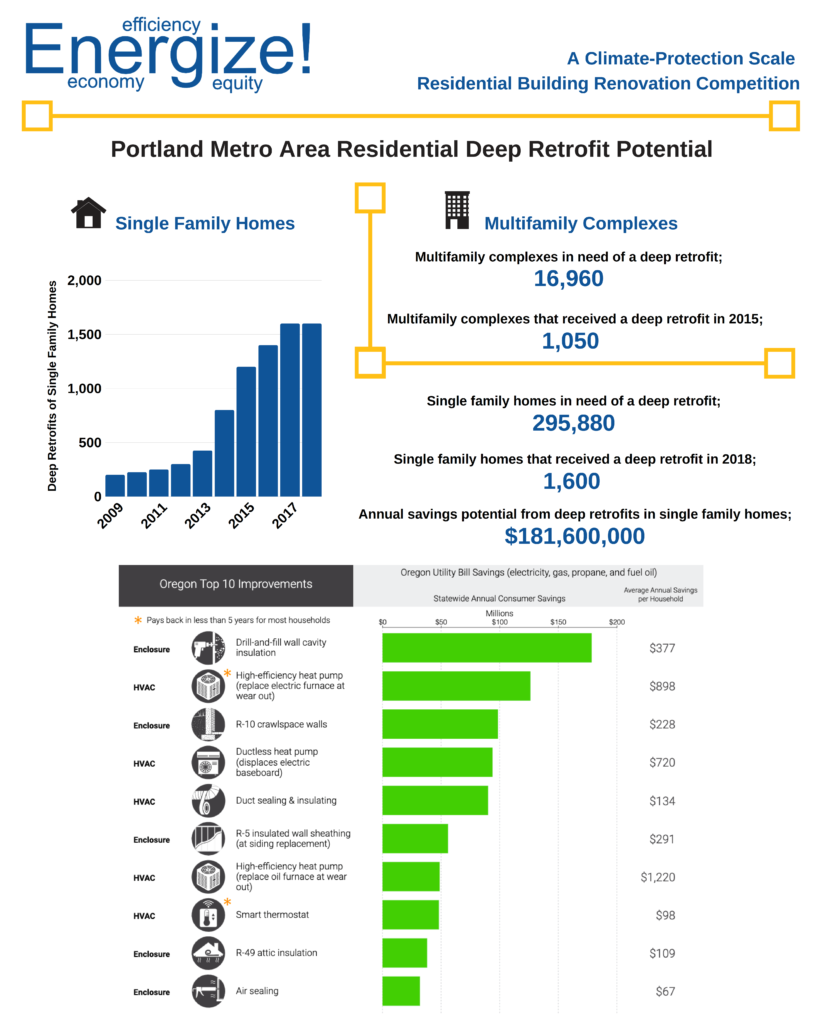Why Energize
Renovating Sustainable Communities
The goal of Energize! is to scale up the savings from residential energy efficiency (EE) and water conservation
programs. Utility efficiency programs are not equipped with the analytics or community engagement
tools required to transform the residential building sector’s efficiency. Based on building age and historical
program data, Res-Intel estimates:
- There are about 17,000 apartment complexes in the Portland Metro area that are in need of a deep energy
retrofit, but only about 1,000 of these received an energy efficiency upgrade (not even a deep retrofit) in
2018. - Only about 1,600 of 295,000 single family residences (SFRs) received a deep retrofit in 2018. At that rate, Portland’s SFR sector won’t be completely retrofitted until the year 2200.
A municipal deep energy retrofit program (that supplements existing utility programs) can appeal to a broader customer
base in order to:
- Reduce the Energy Burden (utility bills as percent of income) of low-income and underserved households. The figure below shows that the lowest income households spend almost 10% of their income on utility bills. (Source: Groundswell (2016). Working
Families Pay the Most for Electricity)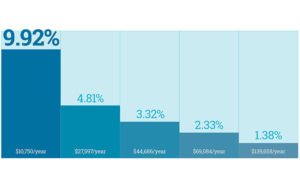
- Reduce utility expenditures in the hard-to-reach apartment sector
- Drive social justice stakeholder engagement by:
- Providing living wage, low-to-medium skill jobs for EE installers
- Offering more workforce diversity than solar photovoltaics (PV)
- Overwhelmingly male & white
- Improve indoor air quality and reduced thermal stress in low-income residences through weatherization and
building upgrades - Engage economic development agencies as EE stakeholders
- Energy security, and job creation appeal to a wider range of citizens and stakeholders than does EE
alone
- Energy security, and job creation appeal to a wider range of citizens and stakeholders than does EE
- Increase local government tax revenues from sales and business taxes
Barriers to Deep Energy Retrofits
- Municipalities have little direct authority to renovate the building sector, as utilities implement EE programs and states control building codes (which apply only to new buildings and major retrofits).
-
- Portland leads the nation with its time of sale building energy rating requirement, but only about 4% of existing homes are sold each year, and its not clear that energy information disclosure leads to EE improvements.
-
- The average American spends ~20 minutes a year thinking about their utility bills (out of 525,600). Energy usage is a low salience item for most residents.
Broader Engagement Requires New Approaches
If stakeholders want to equitably renovate their residential building stock sometime before the year 2200, then new approaches are required. These approaches need to integrate existing EE programs, as well as cost-effectively leverage big data and modern marketing automation tools to reduce staffing demands. Here’s how Energize! works:
- Energize! first provides “benchmarking for the masses”; single and multifamily residential property owners receive a benchmark report with a 1-100 score for their building’s energy use, along with customized conservation recommendations based on their energy usage profile.
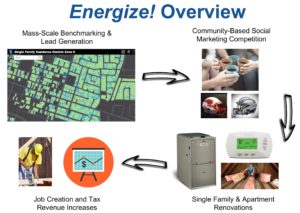
- A competition that localities develop according to their needs to recruit residents in their districts to perform retrofits. For example, the school district (or other geography) that performs the most residential retrofits, and/or achieves the greatest energy savings, wins the competition.
- Community-based social marketing enables cost-efficient recruitment mechanisms by utilizing local governments and community media for competition marketing. The Energize! program media is inserted into existing schools, local business bulletin boards, and neighborhood newsletters. Municipalities act as the implementing agency and coordinate with stakeholders, administer web, direct mail, and other marketing channels.
- Marketing automation provides a range of benefits including creating customized messages, improving customer experience, increasing participation by persuasively engaging participants, as well as saving time and money by reducing the number of staff required to implement the program.
These four elements provide a cost-efficient and effective program to improve the efficiency and equity of the residential building sector.
Res-Intel’s Advanced Analytics and Experience
Res-Intel is deeply committed to energy justice, and see Energize! as an essential tool to improve social welfare. Res-Intel brings Ph.D. social scientists with decades of energy sector consulting and software development experience. In 2011, Res-Intel received the first of two California Energy Commission grants to develop the benchmarking-for-the-masses capabilities. These tools have been used to successfully benchmark all of the apartment complexes in Southern California Edison’s service territory. Res-Intel is currently the lead evaluator for San Diego Gas & Electric’s weather-normalized, metered energy efficiency programs. The firm’s analytics were used in the largest energy conservation competition in the world for apartment complexes. Res-Intel has worked with three of the four investor-owned utilities in California as well as three water agencies.
Previous Results
Res-Intel’s partnered with Southern California Edison and Southern California Gas and three water utilities to provide the benchmarking and analytics for the Communities for Conservation behavioral pilot. The modest prize of $2,500 in Energy Star appliances incentivized apartment managers and tenants to reduce electricity consumption by 1.0-2.0%. Lessons learned from that pilot have informed the design of Energize!, including more salient prizes, multiple behavioral interventions, and the marketing automation platform.
Costs and Benefits
Simultaneously rising social inequalities, sea levels, and greenhouse gas reduction targets are forcing local governments to reconsider the appropriate roles of stakeholders in the local energy savings in a city with a population of 600,000, the Energize! program could reduce annual emissions equivalent to 3.3 million avoided vehicle trips. Approximately $2.0 million in utility expenditures could be avoided by residents and about 2,500 jobs created.
Res-Intel estimates the annual cost of the program as the equivalent of 3-4 full-time equivalent staff (FTE) over the 4 year timeline. One staff member is embedded in the local government coordinating marketing and stakeholder engagement. The fully-loaded cost equivalent of 2 FTEs is required for the analytics, marketing automation, and project management. The other main direct cost is for the building energy retrofit implementer to provide verification and technical assistance for EE projects.
Program Summary
Energize! utilizes data-driven outreach techniques, community-based social marketing, and best-in-class behavioral strategies to drive deep residential energy retrofits. The key mechanism of the program is a residential building renovation competition. The competition is tailored to the unique composition of each locality (e.g. school districts) and is used to recruit residents to perform home retrofits. The residents that perform the most retrofits or achieve the greatest energy savings win the competition and salient prizes. High program uptake is achievable through innovative marketing channels and layered behavioral interventions. Energy savings and pay-for-performance contracts can be developed using EM&V 2.0 methodologies developed by Res-Intel.
What Makes Energize! Different?

Benchmarking for the Masses
Res-Intel efficiently performs benchmarking at scale, enabling peer comparisons and microtargeted energy conservation recommendations.

Behavioral Interventions
Energize! has been designed to maximize participation by including behavioral strategies at multiple levels of the program.

Innovative Marketing Channels
Municipalities perform marketing activities instead of utilities. A marketing automation platform and community-based social marketing are used to reduce costs and improve outreach.
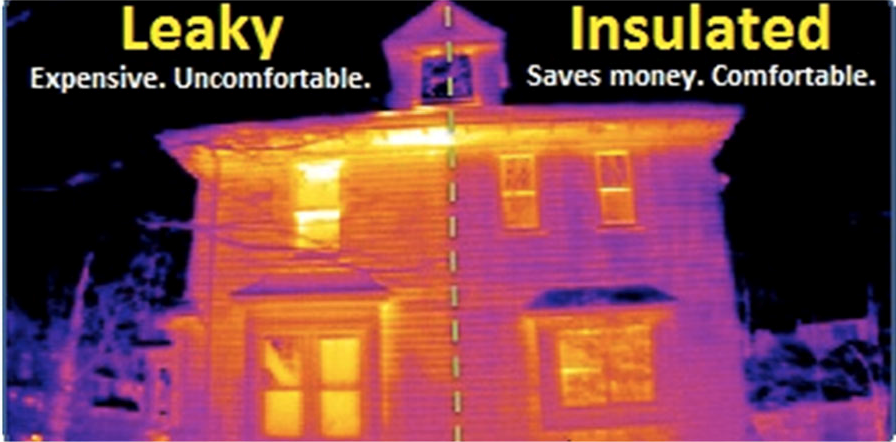
Emphasis on Deep Retrofits
The emphasis on deep retrofits results in increased participation in existing energy efficiency programs beyond the rebates and incentives currently offered.
Timeline and Process
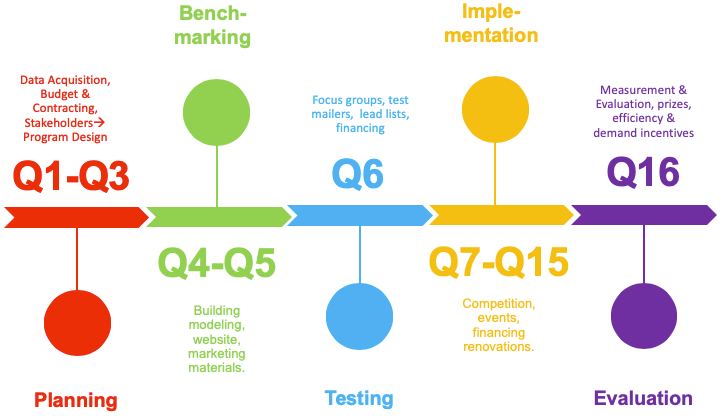
Key Roles and Responsibilities
- Municipality – Program implementation, marketing administration, stakeholder coordination.
- Retrofit Implementor – Deep retrofit project verification, QC, and execution.
- Utility – Rebate processing, data sharing.
- Marketing Agency – Media creation, marketing automation, CRM development.
- Res-Intel – Competition design, benchmarking, database management, EM&V 2.0 evaluation.
Portland Metro Area Deep Retrofit Potential
